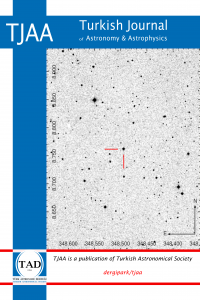NARX Sinir Ağları Yöntemiyle 25. Güneş Aktivite Çevrimi Tahmini
Sun: activity, Sun: sunspots, Sun: solar-terrestrial relations, Neural networks: nonlinear autoregressiveexogenous models
Prediction of Solar Activity Cycle 25 with NARX Neural Networks
sun: solar-terrestrial relations, sun: sunspots, sun: activity, neural networks: nonlinear autoregressive exogenous,
___
- Ahmed U., Mumtaz R., Anwar H., Shah A. A., Irfan R., García-NietoJ., 2019, Water, 11
- Balogh A., Hudson H., Petrovay K., von Steiger R., 2014, SpaceScience Reviews, 186, 1
- Boussaada Z., Curea O., Remaci A., Camblong H., Mrabet Bellaaj, N., 2018, Energies, 11
- Du Z. L., 2020, Astrophys. Space Sci., 365(6), 134
- Guzman S., Paz J., Tagert M., 2017, Water Resour Manage, 31,1591–1603
- Han Y., Yin Z., 2019, Solar Physics, 294, 107
- Hathaway D. H., 2015, Living Rev. Solar Phys., 12(1), 4
- Helal R., Galal A., 2013, Journal of Advanced Research, 4, 275–278
- Li F. Y., Kong D. F. Xie. J. L., Xiang N. B., C X. J., 2018, Journalof Atmospheric and Solar-Terrestrial Physics, 181, 110
- Menezes J., Barreto G. D. A., 2006, 2006 Ninth Brazilian Symposiumon Neural Networks (SBRN’06), pp 160–165
- Menezes J., Barreto G. D. A., 2008, Neurocomputing, 71, 3335
- Petrovay K., 2020, Living Rev. Solar Phys., 17(1), 2
- Sarp V., Kilcik A., 2018, Nonlinear Prediction of Solar Cycle 25
- Sarp V., Kilcik A., Yurchyshyn V., Rozelot J. P., Özgüc A., 2018,Astrophys. Space Sci., 365(6), 2981
- Svalgaard L., 2020, Prediction of Solar Cycle 25
- Uwamahoro J., 2008, Master’s thesis, Rhodes University, core.ac.uk
- Wu S. S., Qin G., 2021, Predicting Sunspot Numbers for Solar Cycles25 and 26 (arXiv:2102.06001)
- Wunsch A., Liesch T., Broda S., 2018, Journal of Hydrology, 567
- Yoshida A., 2014, Annales Geophysicae, 32, 1035
- Yoshida A., Yamagishi H., 2010, Annales Geophysicae, 28, 417
- Yayın Aralığı: Yılda 2 Sayı
- Başlangıç: 2020
- Yayıncı: Türk Astronomi Derneği
Kepler Uzay Teleskobu ve ASAS Görüş Alanındaki Sefeid Türü Değişen Yıldızların Frekans Analizi
Mehmet Oğuzhan ERTURAN, Hasan AK
Ay Çarpma Parlamalarının Gözlenmesi
Evrende Moleküler Bölgeler ve Astrokimya
RTT-150 TFOSC Tayfsal Gözlemleri ile Keşfedilen Kuazarlar
Seyit HÖKELEK, Nurten FİLİZ AK
OPEA Modeli ile Güneş Aktivitesinde X-ışın Flare Davranışının Belirlenmesi
NARX Sinir Ağları Yöntemiyle 25. Güneş Aktivite Çevrimi Tahmini
Mirkan Yusuf KALKAN, Ahmet Talât SAYGAÇ, Diaa FAWZY
Kataklismik Değişen Yıldızlarda Madde Transferinin Bileşen Yıldızların Evrimine Etkisi
GALAH ve Gaia Verileriyle Samanyolu'nda Metal Bolluğu Gradyent Araştırması
Furkan AKBABA, Tansel AK, Olcay PLEVNE
Astronomi Eğitiminde Bazı Doğru Bilinen Yanlışlar
Sinan KOÇAK, İnci AKKAYA ORALHAN
Kimyasal Sıra Dışı Yıldızların Element Bolluklarını Araştırmak İçin Yeni Bir Yaklaşım
